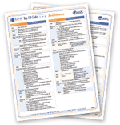| Email not displaying correctly? View it in your browser. | Issue #31 - January 9, 2013 |
|
IN THIS ISSUE
Featured Article ICD-10 EDUCATION
Upcoming |
FEATURED ARTICLE
Have a Heart – Cardiac Overview The heart is the pumping station of the cardiovascular system. It is often referred to as the hardest working muscle in the human body. It sits between the lungs and behind the sternum. It is a fist-sized, cone-shaped muscle that beats nearly 115,000 times per day at an average rate of 80 times a minute. The heart has four chambers: the atria (two upper chambers) and the ventricles (two lower chambers). Left ventricular hypertrophy (LVH) is an enlargement of the left ventricle and may be due to several different things. The most common cause is high blood pressure. LVH increases the risk of myocardial infarction, stroke, and death. In ICD-10-CM, the code for left ventricular hypertrophy is I51.7 Cardiomegaly. The heart is divided into right and left sides by a septum (a muscular wall). While in utero, there is normally an opening between the atria to allow blood to flow around the lungs. The right and left ventricles are also not separated. If the walls don't completely form by birth, the holes are considered septal defects. Ventricular septal defect is one of the most common congenital heart defects. These are congenital conditions; therefore, they are located in Chapter 17 of ICD-10-CM. Code Q21.0 denotes a ventricular septal defect and Q21.1 denotes an atrial septal defect. The heart also has four valves: tricuspid, mitral, pulmonary, and aortic. These valves are fibrous cusps that help the flow of blood throughout the heart by opening to permit blood flow and closing to prevent backflow of blood. The chordae tendineae are tendons made up mostly of collagen that link the papillary muscles to the tricuspid valve in the right ventricle and the mitral valve in the left ventricle. As the papillary muscles contract and relax, the chordae tendineae (sometimes called the heart strings) transmit the resulting increase and decrease in tension to the respective valves, causing them to open and close. Examples of ICD-10-CM codes for these conditions include: I34.2 Nonrheumatic mitral (valve) stenosis, I35.2 Nonrheumatic aortic (valve) stenosis and insufficiency, and I07.1 Rheumatic tricuspid insufficiency. There are also combination codes if multiple valves are diseased. For example, I08.2 Rheumatic disorders of both aortic and tricuspid valves. This is just the "tip of the iceberg" for the cardiovascular system. In coming newsletters, we will revisit this system and delve deeper. The more you understand the structure and function of the organ systems, the more efficient and secure you will be in your coding in ICD-10-CM. IN THE NEWS
CMS Awards Contract to Develop Process for End-to-End Testing CODING SNAPSHOT
PREOPERATIVE DIAGNOSIS: Severe Mitral Valve Prolapse and Regurgitation
ICD-10-CM Codes: Rationale: In ICD-10-CM, codes for valve disease and disorders are broken down by which valve or valves are affected, the type of disorder, and whether the condition is congenital, acquired, or rheumatic in nature. In our case study, the patient has mitral valve prolapse and regurgitation, indicating that the valve is "drooping in" and that blood is back flowing (regurgitating). The default in the Alphabetic Index in ICD-10-CM for mitral valve disorders is nonrheumatic. Unlike ICD-9-CM, ICD-10-CM has separate codes for mitral valve prolapse and mitral regurgitation; therefore, both codes are reported. ICD-10 IMPLEMENTATION STRATEGIESWe will be sharing a number of strategies to help your practice successfully implement ICD-10-CM. Please remember to track your progress in your ICD-10 Implementation Tracker on AAPC's website.
Measuring Productivity FEATURED RESOURCE
Cardiology Crosswalk - Fast Forward to ICD-10 |
|
ICD-10 Tips and Resources is offered as a benefit to AAPC members and we hope you find the information useful. If you'd rather not receive future issues of ICD-10 Connect, please log in to your account and change your email preferences.
AAPC |
|
Copyright © 2013 AAPC - All rights reserved. CPT copyright 2012 American Medical Association. All rights reserved. Fee schedules, relative value units, conversion factors and/or related components are not assigned by the AMA, are not part of CPT, and the AMA is not recommending their use. The AMA does not directly or indirectly practice medicine or dispense medical services. The AMA assumes no liability for data contained or not contained herein. The responsibility for the content of any "National Correct Coding Policy" included in this product is with the Centers for Medicare and Medicaid Services and no endorsement by the AMA is intended or should be implied. The AMA disclaims responsibility for any consequences or liability attributable to or related to any use, nonuse or interpretation of information contained in this product. |


